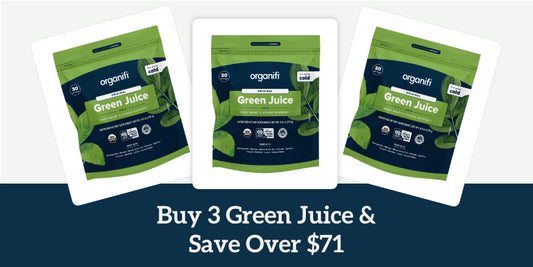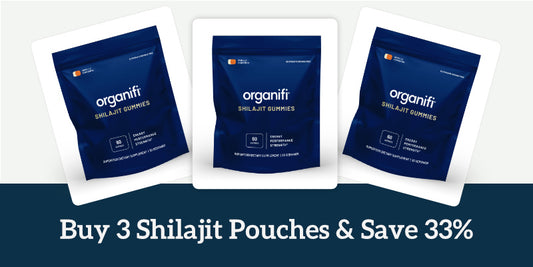Confused about the difference between prebiotic and probiotic?
Don’t worry; you’re in the right place.
By now, you’ve probably seen a headline or two talking about the difference between prebiotic and probiotic foods, how they improve gut health, and -perhaps- for a while, you thought they were one and the same, with maybe just a little misspelling.
Prebiotics and probiotics are not the same.
If you’re:
- Researching how to improve gut health
- Considering gut health supplements
- Looking for foods high in probiotics, or
- Trying to understand product labeling (prebiotic or probiotic?)
This article will help you understand these critical members of our gut’s microbiome, how they affect our health and how to balance them out to achieve peak performance.
If this is the first time you hear about it, that’s ok; science only started to look into the difference between prebiotic and probiotic compounds seriously in the 1970s, using the name “prebiotic” for the first time in 1995.
Gut Health and The Difference Between Prebiotic and Probiotic
You’ve heard the saying “you are what you eat” and that’s true, but more accurately you are what you feed the bacteria in your gut.
The millions of little creatures that inhabit our bodies at a microscopic level have more say in our lives than we give them credit for; the gastrointestinal organs are often called the body’s “second brain.”
This “brain” has the ability to trigger food cravings, regulate the metabolism, change your mood, alter brain functions, support the immune system, and make or break your weight loss goals.
This microscopic ecosystem regulates what we eat and think, according to what we feed it the most; so if you feed it a lot of pizza and fries, it will ask for more of that. That’s the key to the difference between prebiotic and probiotic substances; one actually feeds the other.
The lining of the gut has over 1,000 species of bacteria and the healthier they are, the better you look and feel. You have to help the “good” bacteria grow to avoid those sugar cravings and stay on track with your fitness goals.
So what is the difference between prebiotics and probiotics?
- Probiotics are the good gut bacteria that live in the gastrointestinal tract.
- Prebiotics are the food these bacteria need to thrive.
Both are essential for the body, but the Standard American Diet tends to run short on both. To eat a balanced gut health diet, it’s useful to learn the best sources of prebiotics or probiotics for your system - depending on what you might need the most.
Understanding the difference between prebiotic and probiotic foods will help you grow the good bacteria in your body.
Probiotics: Your Gut’s Friendly Bacteria.
What makes probiotics “good” bacteria in the first place? Do you need them in gut health supplements?
Probiotics are live microorganisms that benefit your body, especially when administered in adequate amounts.
They are considered the “good bacteria” because they naturally live in symbiosis within the intestines and perform vital functions that support overall health; supporting digestion, the immune system, elimination, and more.
These live culture bacteria are quietly eating away prebiotic foods and helping you absorb vitamins, process that spicy taco, and have healthy bowel movements. When they’re balanced, they can prevent bloating, constipation, and infections, but when they’re not - they can lead to anything from bouts of acne to IBS or even depression!
So, is the difference between prebiotic and probiotic compounds that one is more important than the other? No, but they have different benefits.
Top Benefits of Probiotics
- Aid digestion
- Support nutrient absorption
- Prevent disease-causing bacteria growth or infection
- Help maintain immune function
- Protect against harmful fungi and yeast
- Produce natural antibiotics and antimicrobial substances
- Control food cravings
- Help regulate inflammation
- Mood regulation through hormone stimulation
Another way to get clear on the difference between prebiotic and probiotic is learning the names of probiotics you may find in food, drugs, and supplements:
Research shows that the health benefits of probiotics have been found -as of today- only in a specific group of strains that support different parts of the organism. You can find them listed on probiotic foods like yogurt or fortified kefir, with the following names:
- Acidophilus
- Lactic Acid Bacteria
- Lactobacillus
- Bifidobacterium
- Saccharomyces
- Enterococcus
- Streptococcus
- Pediococcus
- Leuconostoc
- Bacillus
- Escherichia coli
Acidophilus, Lactobacillus, and Bifidobacteria are some of the most well-known and important probiotics to improve gut health, which is why they are the names you’ll notice on gut health supplements more frequently.
For example, Acidophilus produces natural antibiotics as well as having antimicrobial effects against Candida Albicans, Lactobacillus helps synthesize Vitamins A and D, and Bifidobacterium Bifidum resists and prevents yeast infections. These are just a few of the many benefits of probiotics.
Other strains like Escheria Coli may be able to treat constipation and prevent ocular diseases, while Streptococcus could fight antibiotic resistance.
Foods High in Probiotics
We’ll get into the difference between prebiotic and probiotic food below; but for now, this probiotic food list can be added to your weekly grocery go-to’s. These foods high in probiotics may not necessarily have added live culture, but are naturally rich in probiotics anyway.
- Aged Cheese
- Fermented or Pickled Vegetables
- Kefir
- Kimchi
- Kombucha
- Microalgae
- Miso Paste or Soup
- Pickles
- Plain Yogurt
- Raw Honey
- Sauerkraut
- Sourdough Bread
- Tempeh
Since many naturally occurring foods high in probiotics come from dairy, vegan and lactose-intolerant people can opt for fortified dairy alternatives, soy, tempeh and gut health supplements.
Prebiotics: What You Need to Know.
Hopefully, you’re starting to get a better grasp of the difference between prebiotic and probiotic substances; but if you’re still a little confused, this definition of prebiotics will help settle the debate:
Prebiotics are non-digestible dietary fibers that stimulate the activity or growth of select healthy bacteria (probiotics)
Prebiotics come from a specific type of carbohydrates, mostly in the form of fiber, that humans can’t digest at all and pass through the small intestine intact. This undigested substance is then fermented within the large intestine and ultimately turned into “food” for the healthy bacteria that inhabit the colon.
The probiotic bacteria use prebiotic compounds to produce nutrients, get energy, and perform their vital bodily functions.
Eating prebiotic foods helps your gut microbiome stay balanced and healthy, boosting the immune system, aiding digestion, and helping you stay happy and fit.
Since probiotics are critical for gut health, prebiotic foods are the fuel they need to keep you healthy. Knowing that you can feed them accordingly and not be intimidated by product labeling that complicates the difference between prebiotic and probiotic food.
Top Benefits of Prebiotics
- Help grow and nourish the good bacteria in the gut
- Promote balanced gut health
- Support regular bowel movements
- Fuel nutrient absorption, immunity and faster metabolism
- Add fiber to your diet
- Prevent sugar cravings
As you can see, the simplest way to explain the difference between prebiotic and probiotic simple: one is alive (PRO) and the other one isn’t (PRE.)
Prebiotic Foods
Not all dietary fiber is prebiotic, food listing “fructooligosaccharides” as ingredients are prebiotic food; however, pectin, nonstarch polysaccharides, and plant wall polysaccharides are not. Additionally, not all prebiotics are made of fiber, but the majority of what you’ll find in gut health supplements are. This list will help you add the right kind of fiber to your diet:
- Almonds and Pistachios
- Apples
- Asparagus
- Bananas
- Barley
- Berries
- Chicory Root
- Cocoa (a healthy chocolate substitute)
- Dandelion greens
- Flaxseeds
- Garlic
- Jerusalem artichokes (not regular artichokes)
- Jicama Root
- Leeks
- Lentils, Red Kidney Beans, and Chickpeas
- Oats
- Onions
- Shallots
- Seaweed
Bottom Line: Prebiotic or Probiotic food?
You should eat both! The difference between prebiotic and probiotic foods is that one has been infused with the live culture bacteria (PRObiotic), while the other feeds them directly (PREbiotic.) Adding these foods to your diet is useful for recovery and prevention.
A healthy gut is a healthy you. Even though it’s important to understand the difference between prebiotic and probiotic foods (to avoid mislabeled products), the easiest thing to do is to try to get as much of a balanced diet as possible. Supplements help you reach that goal with less effort:
Don’t like the dairy or fermented stuff so much? Get a supplement like our Organifi Complete Bundle which has ten super strains of powerful probiotics in one place and will help fix your digestion, speed up your weight loss process, and get more radiant skin.
Foods high in probiotics have that necessary friendly bacteria as added culture, which can be especially beneficial after antibiotic treatment (they kill both the good and bad), stomach flu, a cold or any other issue that affected your immune system - even if temporarily.
Prebiotic foods will make sure they grow, thrive, and keep the unfriendly ones in check. The good news is that both prebiotic and probiotic foods are as tasty as they are healthy. We hope that after this article you can easily explain the difference between prebiotic and probiotic, and share it with a friend that wants to feel and look their best.




